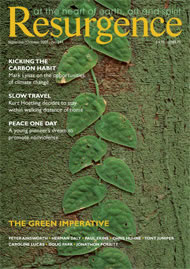READERS OF RESURGENCE need little convincing that establishing the concept of sustainability as the organising principle on our planet, fostering a well-balanced alignment between individuals, society, the economy and the regenerative capacity of the Earth’s life-supporting ecosystems, represents a most urgent challenge for our time. It is a challenge unprecedented in scope. It requires a fundamental shift in consciousness as well as in action. It calls for a deep transformation, simultaneously, in all aspects of human activity including our worldview, our values, our technology, current patterns of consumption, production, investment, governance, trade, and more.
The concept of ‘sustainable development’, as coined by the World Commission on Environment and Development, and with it the term ‘sustainability’ itself, has been gaining increasing recognition in recent years all around the world. Widespread use has been followed by growing ambiguity, however, so that today both terms are employed within a very broad spectrum of meaning, often to the point of trivialisation. Expressions such as ‘sustainable loans’, or ‘sustainable projects’, for example, are often used in international agencies which provide financing for development. The terminology relates to questions of whether loans are likely to be repaid, or if projects are likely to be self-supporting beyond the term of initial backing. It has become completely divorced from deeper and more important questions regarding the very nature of development and its ultimate impact on humans as well as the environment.
If, however, we are serious about ensuring a sustainable future, we need to be guided by more rigorous concepts and by some core principles which could provide clear blueprints or guidelines for the required change.
Few things could offer a better perspective on the deeper meaning of the concept of sustainability than the direct experience of aboriginal peoples and the way their life has always been intimately linked to their environment. In a documentary film on New Guinea, made some years ago, the film-makers interviewed a local tribesman. He was a hunter of birds of paradise, a revered profession passed for generations from father to son. The birds’ feathers are prized for ornamental decorations in sacred rituals. He was telling the story of how he was doing well, having a good wife and owning two pigs. Then one day, he was able to acquire a hunting rifle. Overnight his harvest of birds exploded. With every shot, birds were virtually falling into his hands. He grew rich and obtained a new, younger wife and many more pigs, but suddenly, to his bewilderment, there were no more birds left to hunt.
In a moment of lucid recognition he understood that a ‘profit’ gained today at the expense of tomorrow cannot be considered real wealth. He also saw how the new miracle tool which brought him quick plenty turned into a dark curse, destroying the very resource upon which his livelihood depended. In the ‘old days’, birds were hunted with blow arrows, a much more demanding practice than spraying lead pellet around. It yielded fewer birds with each hunt, but it also left the total stock basically intact. Moreover, in a technique perfected through generations, arrow tips were wrapped with a leather bulb. On impact, a bird would fall to the ground, knocked momentarily unconscious. The few desired feathers would be plucked and the bird, after gaining its composure, would fly away, able to grow a new crop of feathers after a while.
In these simple observations, this native hunter was able to strike at the core meaning of sustainability. His story brought to the fore two crucial aspects: that ultimately, the concept relates to a particular type of balance in the interaction between a people and the carrying capacity of its environment; and that in achieving such a balance some form of self-restraint must be involved. It is this specific kind of balance which must be the focus of a meaningful definition of sustainability, applicable to any population and its related environment: amoebae in a Petri dish, algae in a lake, or humans on the planet.
THE CURRENTLY PREVAILING definition of sustainability emphasises cross-generational equity, clearly an all-important concept for any society that wishes to endure, but one which is operationally insufficient. It often fails to provide unequivocal guidance when specific policy decisions are debated, since the actual, specific wishes of future generations are not easy to ascertain. Anchoring an alternative definition directly to the relationship between a population and the carrying capacity of its environment offers a more advantageous approach since it assumes a number of key variables, all potentially measurable. For example: population numbers; a measure of wellbeing; total inventory and rate of consumption of resources; impacts of by-products generated by human activity on the absorption capacity of the environment; impacts of new technologies in opening or hindering new evolutionary possibilities. Hence the following definition.
Sustainability: a dynamic equilibrium in the processes of interaction between a population and the carrying capacity of an environment, such that the population develops to express its full potential without adversely and irreversibly affecting the carrying capacity of the environment upon which it depends.
This definition points to the dynamic nature of sustainability as a state: a state which has to be calibrated again and again as changes occur in population numbers or in the resources available for supporting all humans at a desired level of wellbeing. It does not seek to define specifically what such a level is, or to limit yet unimaginable possibilities for social evolution. It recognises, however, boundaries and limits which must be maintained by Stone Age tribes and industrial societies alike. As long as the underlying conditions for equilibrium are maintained, the wellbeing of future generations is assured.
The set of sustainability principles that follows is grounded in this definition. The principles are articulated in broad terms but can receive a specific operational meaning in relation to particular sectors of the economy, development issues, business strategies, investment guidelines, or initiatives taken by individuals. They are expressed in relation to five fundamental domains, each representing an essential aspect in the interaction of human populations and the environment. These domains include:
• The Spiritual Domain, which identifies the necessary attitud-inal orientation and provides the basis for ethical conduct
• The Domain of Life, which provides the basis for appropriate behaviour in the biosphere with respect to other species
• The Social Domain, which provides the basis for all social interactions
• The Economic Domain, which provides a guiding framework for creating and managing wealth
• The Material Domain, which constitutes the basis for regulating the flow of materials and energy that underlie existence.
The result is a set of five core principles, each with its own derived policy and operational implications. The set is fundamentally systemic in nature, meaning that each domain affects all the others and is affected by each in return. Rather than a list, the set should be approached and understood as a coherent whole.
THE FIRST PRINCIPLE relates to the spiritual domain, to the basic assumptions we hold about the very nature of reality and the values we hold. It calls for recognising the fundamental mystery which underlies all existence, and the seamless continuum which links us humans, and our technology, with the rest of the biosphere and with the outermost reaches of the cosmos. This principle means honouring the Earth with its intricate ecology; fostering compassion and an ethical perspective in all human affairs; reintroducing a sense of sacredness and reverence to all interactions; linking inner transformation of individuals to transformations in the social collective; and fostering the emergence of a genuine, wise, planetary civilisation.
The second principle relates to the domain of life. It recognises that lasting viability of all complex, self-organising systems – rainforests, coral reef communities, and industrial economies alike – depends on their very complexity. It is their internal variety which allows for emergence and re-emergence of different configurations in response to change. This principle calls for ensuring that the essential variety of all forms of life in the biosphere is maintained. It means assuming a responsible relationship with all species and ecosystems; conserving the variety of existing gene pools; harvesting other species only to regeneration capacity; limiting human encroachment on other life forms; and enhancing biological diversity even in areas of human habitat.
The third principle relates to the social domain. It recognises the need for a new agenda for society based on human dignity, open processes, responsive structures, plurality of expressions, social justice and global solidarity. This principle calls for maximising degrees of freedom and potential self-realisation of all humans, without any individual or group adversely affecting others. It means fostering respect for cultural diversity as the cornerstone for social interactions; establishing universal rights and responsibilities for all individuals and communities; ensuring inclusion in governance and equitable access to natural resources; strengthening co-operation as a basis for managing global affairs; and outlawing war as a method of resolving disputes.
The fourth principle relates to the economic domain. It recognises that the accounting system used at present to guide the economy grossly distorts values by pricing environmental services practically at zero, by repeatedly counting consumption as if it were income, and by ignoring important cost components: ‘externalities’ such as the impacts of depletion, pollution and waste. This principle calls for the adoption of an appropriate accounting system, fully aligned with the planet’s geological, ecological and societal processes. It means employing a comprehensive concept of wealth involving the simultaneous enhancement of all key forms of capital; incorporating critical externalities in all cost accounting; recognising a measure of wellbeing and human development in economic calculations; ensuring that taxation and regulation policies are designed to accentuate desirable outcomes and optimise for the whole; and finding ways for calibrating market mechanisms to reflect true value of the global commons.
The fifth principle relates to the material domain. It emphasises the idea that the limits on possibilities in physical systems and thus on the productive potentials in the use of resources is ultimately prescribed by the primary laws of physics. This principle calls for using superior design to ensure that the flow of resources, through and within the economy, is as nearly non-declining as permitted by natural laws. This means using resources consciously and creatively; cutting out waste; recycling each molecule; and employing new knowledge in order to increase performance with each cycle of use. It also means avoiding depletion of capital resources and increasingly using income sources.
Ultimately, any serious reflection on the concept of sustainability and the five core principles which together prescribe it reveals that the spiritual principle is essential for the possibility of attaining sustainability as an enduring state. It alone underscores the difference between a greedy, egocentric, predatory orientation and a nurturing, self-restrained approach to the world. The spiritual principle drives, integrates and centres the other four principles. It provides the attitudinal orientation that is absolutely essential as a basis of change and, to quote Satish Kumar, “The moment our attitude changes, everything will start to change.”







